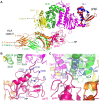Assembly and architecture of the EBV B cell entry triggering complex
- PMID: 25144748
- PMCID: PMC4140853
- DOI: 10.1371/journal.ppat.1004309
Assembly and architecture of the EBV B cell entry triggering complex
Abstract
Epstein-Barr Virus (EBV) is an enveloped double-stranded DNA virus of the gammaherpesvirinae sub-family that predominantly infects humans through epithelial cells and B cells. Three EBV glycoproteins, gH, gL and gp42, form a complex that targets EBV infection of B cells. Human leukocyte antigen (HLA) class II molecules expressed on B cells serve as the receptor for gp42, triggering membrane fusion and virus entry. The mechanistic role of gHgL in herpesvirus entry has been largely unresolved, but it is thought to regulate the activation of the virally-encoded gB protein, which acts as the primary fusogen. Here we study the assembly and function of the reconstituted B cell entry complex comprised of gHgL, gp42 and HLA class II. The structure from negative-stain electron microscopy provides a detailed snapshot of an intermediate state in EBV entry and highlights the potential for the triggering complex to bring the two membrane bilayers into proximity. Furthermore, gHgL interacts with a previously identified, functionally important hydrophobic pocket on gp42, defining the overall architecture of the complex and playing a critical role in membrane fusion activation. We propose a macroscopic model of the initiating events in EBV B cell fusion centered on the formation of the triggering complex in the context of both viral and host membranes. This model suggests how the triggering complex may bridge the two membrane bilayers, orienting critical regions of the N- and C- terminal ends of gHgL to promote the activation of gB and efficient membrane fusion.
Conflict of interest statement
The authors have declared that no competing interests exist.
Figures









References
-
- Rickinson A, Kieff E (2007) Epstein-Barr Virus. In: Fields Virology Knipe D, Fields B, editors. Volume 2. Philadelphia: Lippincott, Williams and Wilkins. pp. 2655–2700.
Publication types
MeSH terms
Substances
Grants and funding
LinkOut - more resources
Full Text Sources
Other Literature Sources
Research Materials

